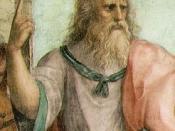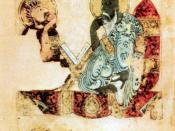Alice Chapman
Explain the relationship between Plato's form of the good and the other Forms (25)
Plato believed that behind every concept or object in the visible world, that there is an unseen reality which he calls its Form. However things such as number and evil don't have a form. The forms may be seen as an ideal image for the particular earthly examples (beauty and trees etc) which Plato calls particulars. He emphasised that the Form's exist in their own right in the world of Forms. They're not just ideas created by people's minds and they exist separately from their particulars. He highlights that there is only one of each Form while there are many copies of that Form, however, they all share common factors to the Form allowing them to be recognised and compared to.
It was seen that the different forms are connected to each other in a fixed order of importance which could be seen as a hierarchy.
Therefore implying that in the physical world there is a hierarchy amongst living things. The Form of the good is represented by the sun and is the 'Form of the Forms.' The sun gives life to all things and illuminates them, enabling to see them for what they really are, enabling us to recognise the other Forms. It is the highest Form and is the highest knowledge that a human is capable of. It is the principle of order which structures the other forms which gives each one its own nature. Without this form there would be no ideal of things such as beauty or justice. Below the Form of the Good are concepts and ideas, living objects and inmate objects. As you get further down the hierarchy and further away from the good, it becomes apparent...


